More people are hitting the yoga mat now than ever before. Because yoga provides so many valuable tools that can be used to improve strength, flexibility, body awareness and focus, numerous athletes have begun to include yoga as part of their weekly training routine. According to Jamie Naughright, Ed.D., cross-training with yoga can be helpful for an athlete because it "improves on the biomechanical compensations an athlete has that may have been caused by acute or chronic injuries."
While including yoga in athletic training may be a relatively new development, the benefits of cross-training have been on the radar for years. Cross-training, according to the American Council on Exercise can reduce your risk of injury, improve your total overall fitness and can help you maintain enthusiasm for regular exercise. Apparently, shaking things up by challenging your body with different types of movement can help you develop in ways that sticking to one single method or routine cannot.
If yoga-based cross-training can help athletes achieve physical balance, then does the same hold true for a yoga practitioner? Can supplementing the time we spend on the mat with strength and cardiovascular training help us optimize health?
To get a better idea of how cross-training can benefit a regular yoga practitioner, I spoke to registered yoga teacher and certified strength-and-conditioning specialist Angelo Gala. Gala claims that cross-training is important for yoga practitioners because many popular yoga classes tend to overdevelop the musculature in the front of the body with a large number of standing strength building postures, abdominal exercises and chaturanga push-ups. According to Gala, adding additional weight-bearing practices to your training can help to right these imbalances by strengthening and stabilizing the musculature in the back of the body and greatly reduce the likelihood of lower back pain, shoulder instability or cranky hamstrings as a result of muscular imbalances.
According to Gala, adding aerobic training to your weekly routine is also important because many yoga classes do not elevate the heart rate long enough to substantially improve overall cardiovascular fitness. The Centers for Disease Control and Prevention recommend at least 150 minutes of moderate-intensity aerobic activity per week or 75 minutes of high-intensity aerobic training per week for overall heart heath. Unless you're able to keep your heart rate substantially elevated for at least 20 to 30 minutes every time you practice, it's probable that you could benefit from some additional cardiovascular exercise.
While there are many ways to integrate cross-training into your weekly yoga practice, Gala recommends just a few days of kettlebell training per week on to fill in the gaps in your overall fitness. Kettlebells, according to Gala, are an optimal tool for yoga cross-training because they can be used anywhere, and because they integrate strength and cardiovascular conditioning into a single practice.
Personally, I integrate these ideas into my weekly routine with an active vinyasa yoga practice on Monday, Wednesday and Friday, cross-training with kettlebells on Tuesday and Thursday, and active rest or long walks on the weekends. Being a yoga purist for many years, I was initially hesitant to do this, but since starting this approach a few years ago I have found that my yoga practice has improved substantially. Previously challenging arm-balances are easier to hold, many of my chronic aches and pains have dissipated and my overall muscular endurance has grown substantially. Off the mat, I've found that maintaining a healthy body weight is easier, and I no longer feel winded when I have to run as fast as I can to catch the bus on my way to teach a yoga class.
Are you ready to give it a try? Check these five yoga cross-training exercises from Angelo Gala.
Exercise 1 -- The Kettlebell Swing
An explosive deadlift that stimulates all the major muscle groups in one fast movement. The swing also stretches and strengthens the hamstrings, teaches one how to control full-body tension (as if flicking on and off a light switch), and develops enough cardiovascular capacity to get up and run a 5k with no previous acclimation.
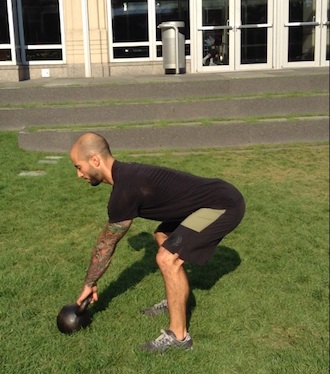
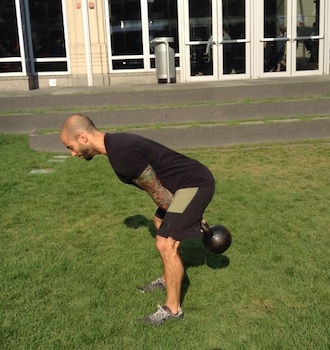
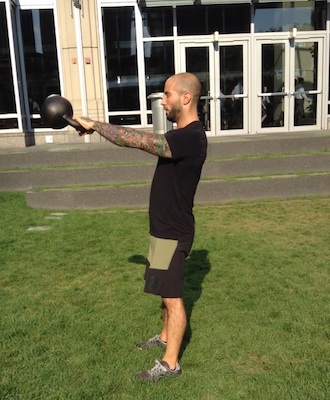
Execution:
-- Set up by standing with feet shoulder-width apart, a full step behind the kettlebell
-- While keeping a neutral spine, reach your bum backwards until you feel your hamstrings stretch and your knees have to bend in order to grab the handle
-- Pull the bell through your legs to give it momentum then quickly press your heals into the ground while tightening up all the muscles of your body to bring your posture fully upright, pushing the bell out in front of your body
-- Once the bell loses momentum (at about shoulder height), guide the bell back towards your hips and fold back into the safe deadlift pattern (long spine and hips back)
-- Repeat
Exercise 2 -- The Push Press
This is a hip-powered shoulder press that rapidly takes a kettlebell from the shoulder rack position to the overhead position. The exercise develops explosive hip power, shoulder strength, upper chest and tricep muscles.
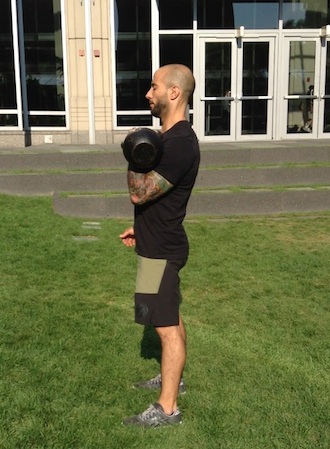
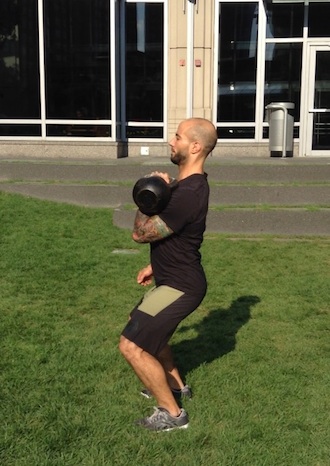
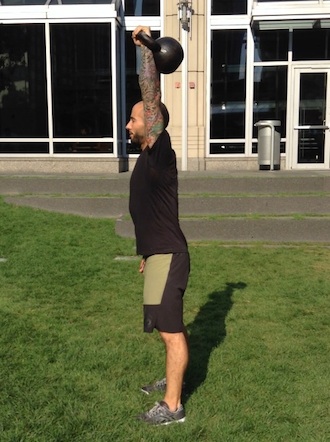
Execution:
-- Rack the kettlebell against the outer chest and shoulder
-- Dip by bending the knees to quarter-squat depth, pushing in line with the toes
-- Quickly straighten legs and squeeze bum to drive the bell from the rack to overhead position
Exercise 3 -- The Goblet Squat
This variation of the squat teaches proper squat mechanics, opens up tight adductor (groin) muscles, evenly challenges quadriceps and hamstring muscles, challenges the core and even strengthens the biceps.
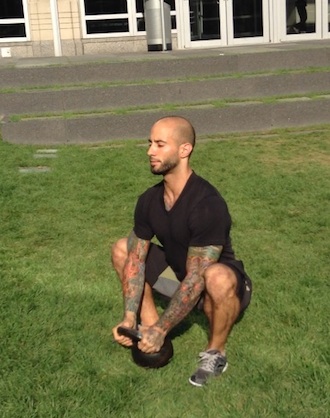

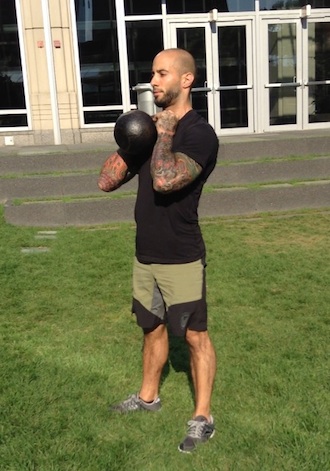
Execution:
-- With feet shoulder-width apart, sit down in the bottom position of a squat by reaching your bum back and down towards your heels
-- Reach down and grab the sides of the kettlebell's handle with each hand, pinning your elbows inside of your knees
-- Bicep curl the handle all the way up to your collarbone, simultaneously prying the knees apart
-- Actively press your knees apart even more then stand up until your ears, shoulders, hips, knees and ankles are stacked in one long line
-- Descend back down into the bottom of the squat, pinning your elbows inside your knees prying them apart
-- Lower the bell to the ground
Exercise 4 -- Elevated Single-Arm Plank-Row
-- This is a monster anti-rotational core exercise and upper-body pull that will strengthen the belly and back musculature like no other.
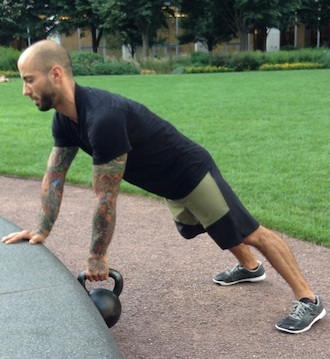
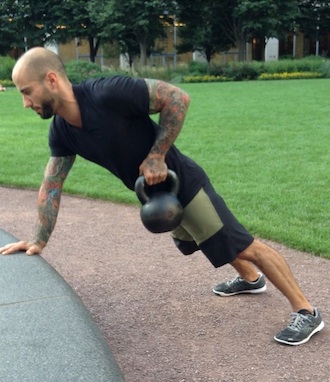
Execution:
-- Establish a two-arm plank on a riser roughly one to two feet above the ground, placing the kettlebell directly under your shoulder
-- Release the arm over the kettlebell, grab the handle and pull the kettlebell all the way up to the same-side hip
-- Be sure to keep the body straight and rigid in order to prevent any rotation of the body
Exercise 5 -- Overhead Back Lunge
Can we get enough core exercises? I don't think so! This is one of the best movements one can do to challenge core stability, strengthen the legs and all the muscles of the arm while stabilizing the shoulder.

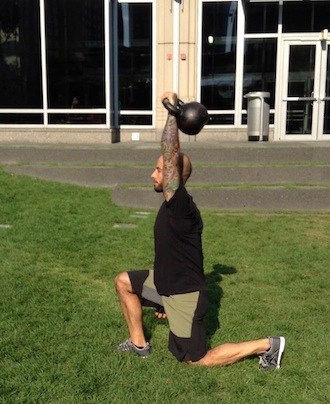
Execution:
-- Bring the kettlebell to the overhead position
-- Step back into a lunge with the leg under the kettlebell
-- With control, bring the lunging knee to the floor
-- Return the lunging leg forward to the start position
Additional notes for practice:
When you practice, note that each exercise should be practiced in a circuit either two to three three times per week for about 20 minutes at a time. All of the exercises besides the kettlebell swing have a target repetition range of six to 12 reps for two to four sets, in order to provide enough stimulus to develop strength in the targeted muscle groups. The kettlebell swing can be practiced for 10 to 20 repetitions at a time with equal work to rest ratios.
To increase the cardiovascular demand, simply subtract time from the rest intervals. For a workout that creates a massive metabolic/cardiovascular demand, throw in a set of 10 kettlebell swings in between every strength exercise allowing for minimal recovery.
*Since strength is variable, to determine the best-sized weight to use for these exercises, speak to a fitness professional at your local or online athletic distributor
Always exercise caution when learning a new exercise. If you are unsure of how to perform any of these exercises safely, seek the assistance of a registered kettlebell instructor in your area.
Follow David Magone on Facebook.
For more by David Magone, click here.
For more on fitness and exercise, click here.